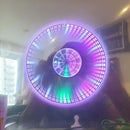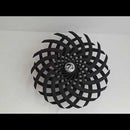Introduction: Shree Yantra Clock
I have a fascination for clocks and love making different types and styles. When I saw the MUSE Swiss Art Watches Kickstarter campaign, I knew that I simply had to create something like it.
I neither have the resources nor the skills to create a wrist-watch as beautiful as the ones created by them; however, a wall clock - that's more my style.
I didn't want to copy their designs exactly but develop their concept and make it mine. While thinking about the concepts, I remembered the Shree Yantra - used for meditation and considered a "Sacred Geometry". It is the symbolic representation and the two-dimensional view of the golden-coloured mystical mountain called Mahameru, which is said to be at the center of the universe, with nine settlements guarded by eight mountains.
The origin of Sri Yantra can be dated back to 2500-3000 B.C. It is a mystical symbol and remains a challenge to our modern scientific knowledge. This particular sacred symbol has undergone much intensive research globally for several hundred years. Scholars conclude that the invisible power of "the Queen of the entire universes" can be visualized from Sri Yantra only during the time of meditation.
It represents the forces that shape all forms in the universe, through two opposing forces: Shiva, the masculine energy and Shakti, the feminine energy. Shiva is represented by triangles pointing upward, and looking at them we can think of a mountain, an arrow, a flame, symbols for stability, meditation, assertive action, and fire. Shakti is represented by triangles aligned downwards, reminding us of a container, a uterus, standing for receptiveness to create. All creation, all that moves, dances, grows, breaths is Shakti. And as colors need an empty canvas, as music needs silence, as dance needs empty space, so Shiva and Shakti are interdependent, like the energies within us.
Mysticism aside, the pattern is extremely beautiful and engaging; it has a complexity that belies the simplicity of the shapes; it is simply beautiful.
The central figure is composed of nine interlocking triangles. Every triangle is connected to the others by common points and this is the reason why it is so difficult to draw correctly. Changing the size or position of one triangle often require changing the position of many other triangles.
There are many different variations of the Shree Yantra and the following links provide additional information:
Step 1: Creating the Pattern
There are many ways to create the pattern from scratch
http://sriyantraresearch.com/Construction/how_to_d...
However, I took a short-cut and downloaded an SVG from Wikimedia to create the pattern
https://upload.wikimedia.org/wikipedia/en/8/81/The...
I modified this SVG in Inkscape to simplify it and create a double outline. The initial plan was to lasercut this pattern using my K40 laser cutter; however, I wanted something bold and big - so the plan was ruled out. Finally, I created a multi-page PDF that I could print and stick together to form the full pattern.
I taped this full pattern onto a large black mount-board and cut the triangles out using a metal scale and a craft knife.
The last step was to add a red triangle to the back of one of the smaller triangles in the pattern to mark the hour hand (see image).
Step 2: The Clock
This is a simple step, I bought a large clock mechanism from Amazon (I'm sure there are other options available, but this was available in Prime and delivered the next day):
https://www.amazon.co.uk/gp/product/B01EQZUO64/ref...
The next part was extremely simple, I cut the center part of the hour hand and fit it to the pattern we had created in the previous step. Fixed it back on the clock mechanism, along with the minute hand.
Set the time and voila - you have a Shree Yantra clock.

Participated in the
Clocks Contest
















